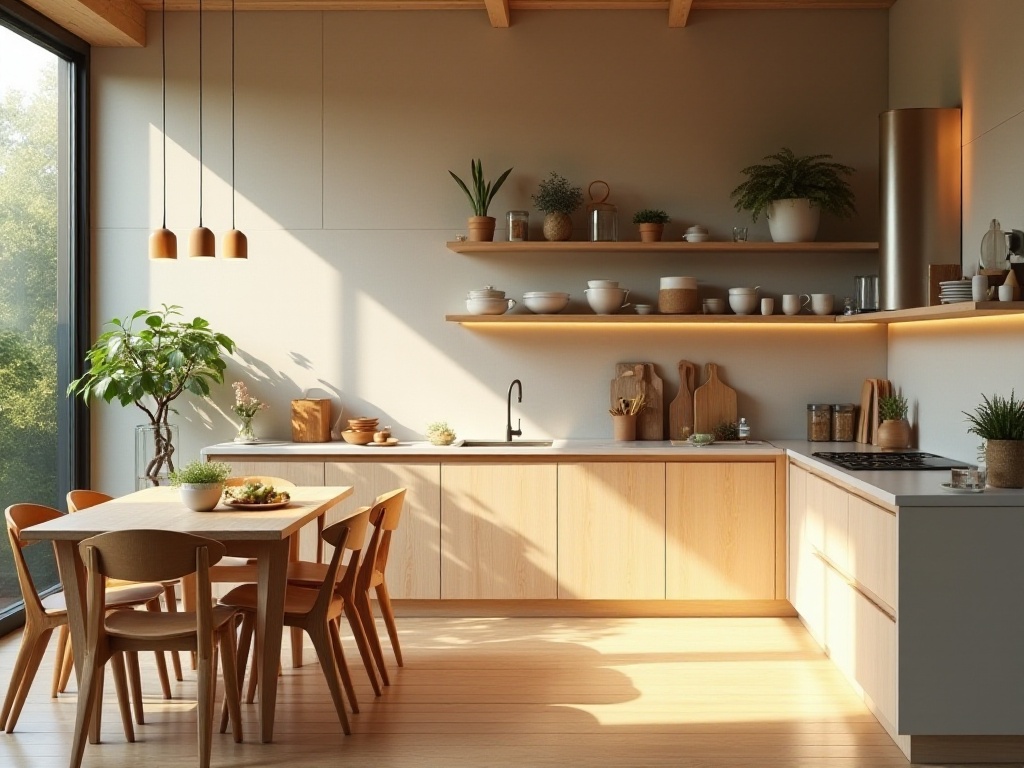Introduction
Every time I see the messy kitchen scene, it's so frustrating! Pots and pans scattered everywhere, spending ages digging through cabinets to find seasonings, and discovering "surprises" of expired ingredients in the fridge. I used to be like this too - my kitchen was basically a storage room, and I had to spend so much time finding things whenever I cooked. After continuous exploration and experimentation, I finally found some really effective organization methods. Now my kitchen looks completely renewed, and it's so therapeutic to look at every day!
Space Planning
The most important part of organization is planning first. Although my kitchen isn't large, proper planning has uncovered quite a bit of storage space. First, I divided the kitchen into three zones: prep area, cooking area, and cleaning area. The prep area mainly holds cutting boards and seasonings used when preparing ingredients; the cooking area is around the stove for cookware and cooking utensils; the cleaning area includes the sink and surrounding space for washing and drying.
To make storage in these three zones more orderly, I also categorized items into three groups based on frequency of use. The first category includes daily items like seasonings, cutting boards, and woks - I put these in the most accessible places. For example, seasonings are on a wall-mounted rack near the prep counter, and the wok hangs on hooks next to the stove, within easy reach.
The second category consists of appliances like rice cookers, air fryers, and blenders that are used several times a week. I usually keep these in middle-level cabinets - not taking up prime space but still fairly accessible. I recently got dedicated storage boxes for these appliances to keep them dust-free and ready to use.
The third category includes items like hot pot cookers, large steamers, and special cake molds that might only be used once or twice a month. These are stored in the highest or lowest cabinet shelves. While not the most convenient locations, it doesn't matter much since they're rarely used. This also prevents these infrequently used items from occupying valuable prime storage space.
This is how my kitchen is organized. When I first started renovating, I even drew a simple floor plan marking what would go in each area. This made the whole organization process more systematic and prevents things from getting misplaced later. Now when cooking, everything is where it should be - no more searching all over the kitchen, and efficiency has improved tremendously!

Storage Tips

Drawer Organization
When it comes to drawer organization, there's a lot to say. My drawers used to be like a "treasure chest" - chopsticks, spoons, spatulas, scissors, all kinds of utensils just tossed in, and finding anything was like archaeology. Then I discovered adjustable dividers, and everything changed!
I bought several expandable drawer dividers and divided the drawers into compartments of various sizes based on different items. The chopsticks section is narrower, the spatula section wider - everything has its own dedicated space. The best part is these dividers can be adjusted anytime, so if I buy new tools, I can easily make room for them.
Spice storage is particularly worth mentioning. I dedicated a large drawer to spices, divided into small compartments. Every spice stands neatly like a little soldier, all bottles clearly visible. I even put small labels in front of each compartment with the spice name, so mixing them up never happens anymore. Most importantly, since I can see all spices at once, I never accidentally buy duplicates anymore.
Another technique I find particularly useful is using double-layer storage in drawers. By putting a supported storage box in the drawer, it becomes two levels. I use this method for small utensils, with chopsticks and spoons on top and less frequently used special utensils below, instantly doubling the space utilization.
Recently I discovered another clever storage method - laying cork mats in drawer bottoms. This not only prevents utensils from sliding around but also reduces noise, making opening and closing drawers super smooth and quiet.
Wall-Mounted Storage
Wall storage is truly amazing! I used to think walls were just for tiles, but now I realize they're a treasure trove of storage space. I've installed several storage solutions on my kitchen walls, and each one is super practical.
First is the magnetic knife holder - it's incredibly useful! Previously, knives were either stuffed in drawers where they could be dangerous, or taking up counter space in a knife block. Now, all the knives line up neatly on the wall, both safe and space-saving. I chose a magnetic holder with protective sheaths, so each knife has its own cover - just pull it out when needed and cover it when done, making it extra safe.
Then there's the pot lid rack, which solved a major problem for me. Before, pot lids were lying all over in cabinets, hard to find and likely to chip tiles. Now I have a dedicated wall-mounted lid rack, with a place for each lid and easy access. I even installed a small tray underneath to catch any water that might drip from the lids.
Besides these, I installed a multi-functional shelf on the wall for commonly used seasonings and small tools. It's the type you can freely combine, and I added several small hooks for hanging measuring spoons, strainers, and other small items. Recently I added a cutting board rack too, so boards can stand upright - saving space and drying faster.
The most important thing about wall storage is considering weight capacity. I always pay special attention to load-bearing capacity when choosing racks, and make sure to use solid expansion bolts during installation for safety. Also, I recommend choosing rust-resistant materials, since kitchens can be quite humid and regular iron racks can easily rust.
Categorized Storage
Ingredient Management
Ingredient storage is probably the most headache-inducing issue. My fridge used to be a "black hole" for ingredients - things would go in and be forgotten until they spoiled. After changing my storage method, ingredient management is now perfectly organized.
First, I did a major fridge cleanup and bought many transparent storage containers. These boxes come in various sizes to match different ingredient portions. I labeled each box with not just the ingredient name but also purchase or storage date. Now I can clearly see the status of every ingredient as soon as I open the fridge.
I now pay special attention to zoning ingredients. The crisper drawer is specifically for fresh vegetables and fruits, and I store them by category. For leafy greens, I first absorb moisture with kitchen paper, then store them in ventilated containers to maintain airflow and prevent yellowing. Fruits are also stored separately by type, with easily damaged ones like strawberries in special fruit boxes.
The refrigerator compartment is divided into several zones: cooked food, dairy products, condiments, etc. Each zone is separated by storage boxes to prevent flavors from mixing and cross-contamination. Notably, I put a small whiteboard on the fridge door to track easily expired ingredients and check it weekly.
For ingredient management, I think the most important principle is "first in, first out." When buying new ingredients, I always put them behind existing ones and move older items to the front. This ensures all ingredients are used within their shelf life.
Also, not all ingredients should be refrigerated. Tomatoes, for instance, taste better stored at room temperature in a ventilated place. Garlic and onions go in dedicated ventilated baskets to stay dry without spreading their smell. Bananas shouldn't be refrigerated either - I hang them on a special banana holder to avoid bruising and ensure even ripening.
Utensil Arrangement
When it comes to kitchen utensil storage, there's quite a bit to learn. I used to just stuff pots and pans into cabinets randomly, which took up space and risked scratches. Now I've learned several storage tricks that keep utensils both organized and well-maintained.
First, about cookware storage. I now use the "nesting method," stacking similar-sized pots together with soft cloth or special pot protectors between them. This not only prevents scratches but also saves space. For frying pans and woks, I categorize them by size and store them vertically in dedicated dividers, making them very easy to access.
Particularly worth mentioning is the storage of spatulas, ladles, and other cooking tools. I installed a multi-functional rack with many small hooks on the wall near the sink for hanging various tools. This makes them easy to access and drain after use. Plus, hanging them vertically takes up very little space.
Tableware storage also requires careful thought. I've divided tableware into three categories: daily use, guest use, and special occasion items. Daily-use items go in the most accessible drawer, with dividers separating chopsticks, spoons, and forks. Guest tableware is stored in middle-level cabinets, organized in storage boxes for easy access when needed. As for the particularly delicate items, they're kept in special dust-proof boxes in higher cabinets.
Small appliance storage is also important. While I don't have many appliances, I do have a rice cooker, food processor, and bread maker. I arrange these based on frequency of use. The rice cooker, used daily, stays on the counter; the bread maker, used less often, is stored in a cabinet to be taken out when needed.
Recently I got dust covers for each small appliance, so they stay clean even when left out. I keep all appliance manuals and accessories in a folder for easy reference when needed.
Daily Maintenance

Regular Cleaning
Organization isn't a one-time task - it needs regular maintenance to stay tidy. I've developed a habit of doing a major cleanup every three months. This frequency is just right - not so often that it becomes bothersome, but not so infrequent that things accumulate too much.
Each major cleanup follows a fixed process: First, check ingredients and identify expired or nearly expired items. For items nearing expiration, I try to use them quickly or share with neighbors if I can't use them in time. Then clean all storage items like containers and racks - everything gets a good wipe-down. Finally, adjust storage arrangements based on recent usage patterns to optimize storage space.
During my last major cleanup, I found several nearly expired seasonings. Instead of throwing them away, which seemed wasteful, I used them to make some pickled dishes that turned out surprisingly well. Since then, I've set reminders on my phone to track seasoning expiration dates so I can use them in time.
During cleaning, I also check all storage tools for maintenance needs. Things like whether drawer slides need oiling or if shelf screws are loose - catching these small issues early prevents them from becoming big problems.
Building Habits
Honestly, the most important part of keeping a kitchen organized is developing good habits. I've now formed some fixed habits that, while requiring conscious effort at first, have become natural over time.
For example, always returning items to their proper place immediately after use, not leaving them out for convenience. When cooking, putting away seasonings right after using them rather than waiting until everything's done. This not only maintains tidiness but also prevents seasonings from getting damp or their flavors mixing.
Shopping is also crucial. I no longer stockpile things - before each shopping trip, I check what we have and make a list before going to the supermarket. This prevents buying duplicates or impulse-buying ingredients that won't get used.
Most importantly is developing a "less is more" mindset. If you notice an item hasn't been used for a long time, consider whether you really need to keep it. Like the special molds I collected - when I realized I wasn't using them, I gave them to a friend who loves baking. She gets to use them, and I gained storage space - a win-win situation.

Experience Sharing
Speaking of organization experiences, I want to share the story of helping a friend organize their kitchen last year. My friend's kitchen was tiny, only 4 square meters, and open-plan - it seemed really challenging at first.
But through proper planning, we made this small kitchen perfectly organized. First, we subtracted - removing all infrequently used items and keeping only what was truly needed. Then we fully utilized wall space, installing foldable shelves that could be collapsed to save space when not needed.
We installed sliding storage racks under the sink for cleaning supplies and trash bins. The space under the counter wasn't wasted either - we used modular storage boxes that could be adjusted as needed. Finally, we added a bar counter at the kitchen-living room partition that serves as both dining table and storage for small items.
This experience taught me that even the smallest space can become neat and practical with good planning. The key is learning to choose what to keep and what to let go, maximizing the use of limited space.
Important Notes
When implementing these storage solutions, there are several important points to consider. First is safety, especially with wall-mounted storage. All shelves and racks must be securely installed with appropriate weight capacity - convenience should never compromise safety.
Ventilation is also crucial. Many people pack items too tightly trying to maximize storage, which can lead to bacterial growth. Leave adequate space for airflow when organizing, especially when storing food items - proper ventilation is essential.
Practicality must also be considered. Even the most perfect storage solution is useless if it doesn't match usage habits. Like when I tried storing seasonings on very high shelves - while it looked neat, it was terribly inconvenient, so I moved them back to within easy reach.
Conclusion and Future Outlook
Through this period of organization, I've deeply experienced how much a tidy kitchen can change life. It's not just about having more space - more importantly, it improves mood. Every time I enter the kitchen and see everything neatly arranged, cooking becomes a real pleasure.
I believe organization is a continuous improvement process - there's no best, only better. Continuously summarizing experiences through practice and adjusting based on your usage habits is how you find what works best for you.
Actually, everyone might have their own unique organization tricks discovered through daily life. If you have any good storage methods, please share them in the comments - let's create more comfortable living spaces together.







